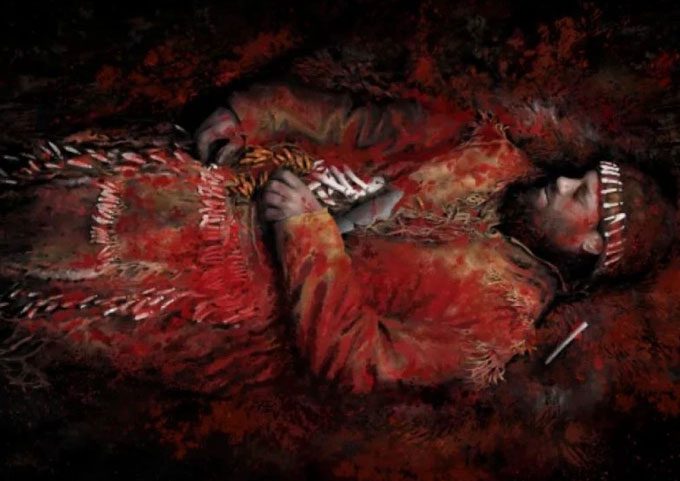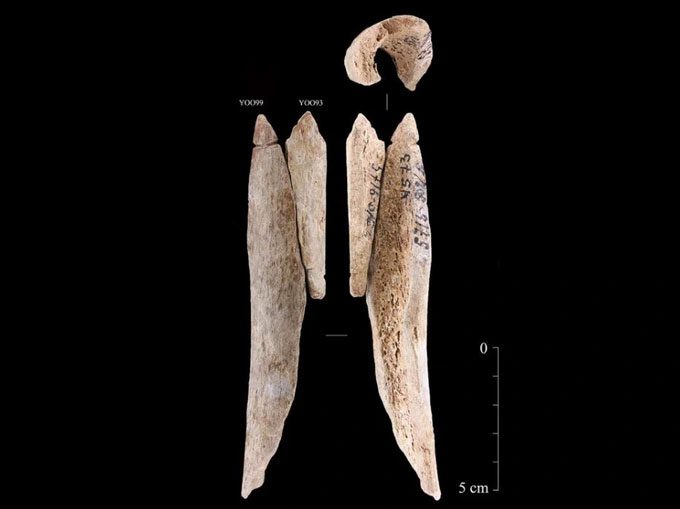A recent study has provided the first evidence of the use of human bones in the production of pendants by hunter-gatherer communities in Northeastern Europe.
Prehistoric humans used items such as claws, feathers, shells, and teeth to decorate clothing and jewelry, marking group membership or serving symbolic purposes in community rituals.

Reconstruction of one of the prehistoric burial sites on Yuzhniy Oleniy Ostrov, Karelia, Russia. The man from grave 69 wore a pendant made from human bone mixed with moose teeth (Photo: TOM BJÖRKLUND).
Prehistoric individuals were buried with various adornments. These items have been found in graves, and scientists discovered that these pendants were made from the teeth and bones of animals including mammals, birds, fish, and mollusks.
Notably, a new study published in the Journal of Archaeological Science has indicated that human bones were also used as materials to craft these ornaments.
Experts in the research team analyzed 8,200-year-old pendants discovered 80 years ago on Yuzhniy Oleniy Ostrov (Russia), which were made from human bones, not animal bones.
This island is located on Lake Onega in Northwestern Russia and is referred to as a Paleolithic cemetery. Russian archaeologist JF Ravdonikas studied it from 1936 to 1938, uncovering a significant amount of adornments during the excavation of 177 graves.
Additionally, a study conducted in 2020 at the same site revealed that prehistoric humans used moose teeth to create sounds for dances or rituals.
The study’s results indicated that prehistoric people detailed their presence with pendants made from teeth, particularly the incisors of the Eurasian moose (Alces alces), beaver, and brown bear canines (Ursus arctos). Among the items created, some were made from human bones.
Professor Kristiina Mannermaa at the Helsinki Institute of Science (HELSUS), along with colleagues, is conducting further research to accurately identify the bones of these animals.
To achieve this, the skeletons were sent to the BioArch Research Center at the University of York in the UK for archaeological analysis using mass spectrometry (or ZooMS). This technique identifies species from peptides or amino acids extracted from proteins in bone samples.

Two pendants made from human bones carved from femur bones from the Yuzhniy Oleniy Ostrov site, Karelia, Russia (Photo: Anna Malyutina).
The results surprised the research team, as a large amount of bone decorations found in 22 graves were human bones.
Professor Kristiina Mannermaa stated in a press release from the University of Helsinki: “These results are astonishing; 12 out of 37 analyzed bone samples turned out to be human bones, specifically long bone fragments. This indicates that prehistoric humans knew how to mix elements of human origin with those of animals.”
According to Professor Mannermaa: “The earliest use of human bones as raw materials for crafting decorations dates back to the Aurignacian period, approximately 35,000 years ago in France, as well as around 29,000 years ago in Pavlov and Dolni Vestonice, Czech Republic.”
For example, in Scandinavia (a subregion in Northern Europe), perforated human teeth have been found in graves in Denmark dating back to 6,000 BC, and in central Anatolia (Turkey), over 7,000 years ago.
This practice persisted in the context of using jewelry and adornments, as the use of bones for tool-making is known from the Mousterian period (Middle Paleolithic) in La Quina, France (53,000-33,000 years ago), where skull fragments were used as tools to modify community items.
Kristiina Mannermaa explained: “The use of human bones is often associated with cases of cannibalism, similar to what has been found in Cough Cave in the UK (around 12,700 years ago). We attempted to identify any cut marks on the bones of the decorations at the Yuzhniy Oleniy Ostrov cemetery.”
However, the wear on the objects made it impossible to distinguish whether they were victims of cannibalism.
Professor Kristiina Mannermaa added: “The fact that the use of human bones has not been clearly emphasized in previous studies is significant. We know that the blurring of such forms and boundaries has been and remains a part of the worldview of indigenous peoples.”
On the other hand, human bone decorations may also be preserved as relics of ancestors or family members, and it should not be forgotten that they could sometimes be trophies taken from slain enemies.
This research is funded by the Kone Foundation (Finland) and the European Research Council (ERC). It is a project aimed at uncovering the social relationships between humans and animals by using burnt materials collected from the graves of hunter-gatherer communities in Northeastern Europe.


















































